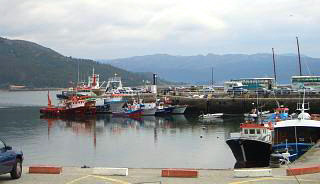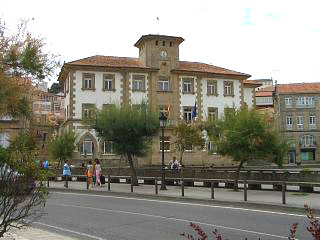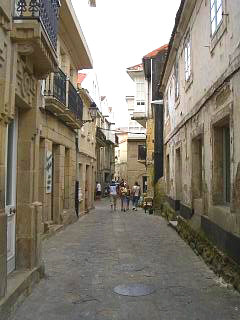Muros Galicia 2 - some history
Muros has been declared a town of historic and architectural significance and many of its structural features are now protected. Originally it was one of the largest fishing ports in the ria and still benefits from deep waters that allow some of the larger fishing vessels to port there. Traditionally the ships at Muros land their catch in the early evening and make shift markets are set up as soon as the boats approach so that the catch can be sold whilst it is still fresh. If you wonder down to the harbour you will see a collection of different vessels of varying sizes, some moored up and others putting out to sea.

Buying fish, or shellfish, directly from an incoming catch is not just the something for the fish merchants. Anyone can buy from the local catch at these auctions and prices are very reasonable. It is also during the evening time that the specialist sea food based tapas bars are at their best serving snacks that have been caught only hours earlier.
Architecture and town geography
Aside from its typical Galician coastal stepping, Muros also features many narrow and colonnaded streets that give the town an almost claustrophobic atmosphere, especially as you walk in the alleys and pathways behind the sea front facing miradored buildings.
These areas can be accessed through narrow tunnel like corridors along the length of Muros's main road, or by walking to the town square which has an almost regal town hall (near the harbour) and entering the older district behind the more touristified shops.

A photo of the Town Hall which dominates the western end of Muros.
As with most of Galicia's urbanisations, granite is the building material of choice and as you escape the miradors overlooking the bay, a more sombre style of architecture takes over. The colonnades, for which Muros is famous, keep the old town cool during summer and sheltered during winter, and also ensure protection from both the suns rays and any chilling winds. The narrowness of some of these alley ways cannot be over exaggerated, nor can the steepness of some of the many flights of steps that take you vertically from one level to the next.
Below, one of the many, and in this case wider, colonnaded streets in the older and darker part of Muros (see Muros guide page 3 for more pics).

Churches
Muros has no shortage of churches and chapels and to prove the point here's a list of just a few. The seventeenth century chapel of Nuestra Senora de la Angustia, the chapel of San Roque (also circa 17th century), the church of San Pedro de Muros and the church of Santa Maria.
Some of these religious structures are grand whilst others, one in particular, are no more than the size of a bike shed.
Civic buildings also come in many shapes and sizes, but the original market building, from which Muros's outdoor market radiates, is especially attractive. It is two storeys in height and although quite small dominates the small piazza in which it is located.
 It is also framed, either side, by two other attractive and typically Galician buildings which make the square very appealing. On market day this entire area is full of stands and the hustle and bustle of traders and shoppers.
It is also framed, either side, by two other attractive and typically Galician buildings which make the square very appealing. On market day this entire area is full of stands and the hustle and bustle of traders and shoppers.
Right, the old stone market building located behind the sea front facing properties.
Although most visitors get their drinks and tapas from one of the many bars overlooking the bay, there are several quieter, but still active, eateries in this more hidden part of town. On a market day it can get hectic, but at other times there is a more relaxed atmosphere and you will feel that you are experiencing the Muros of the more discerning visitor rather than that of the holiday maker.
Muros is incidentally one of the coastal town reputed for the quality of its tapas, especially that focussed on seafood, so a visit to Muros should always involve the sampling of one of the local specialities along with the obligatory glass of wine or beer. If you visit this part of Galicia, Muros is a must see stop on your journey!
For details of the fiestas of Muros and the nearby town of Louro, plus some photos of colonnades in Muros, click on this link
Muros guide 3

